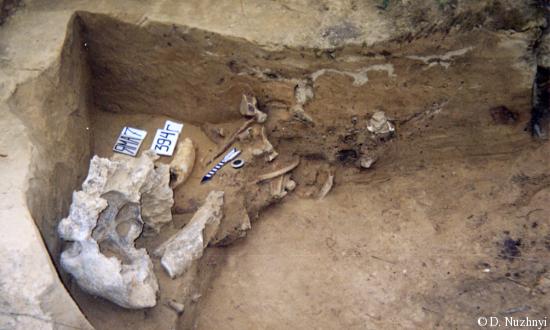Press Releases Archive
29.08.2018
Diet Change with Fatal Consequences
Eastern European Woolly Mammoths changed their diet shortly before becoming extinct
Frankfurt, 08/29/2018. Senckenberg scientists, together with an international team, studied the potential cause of extinction of the Woolly Mammoth 18,000 years ago. In their study, recently published in the scientific journal “Quaternary Research,” they concluded on the basis of isotope analyses that the mammoths had to change their feeding habits shortly before becoming extinct. This forced environmental adaptation, combined with hunting pressure from early humans, ultimately led to the mammoths’ demise.
Woolly Mammoths (Mammuthus primigenius) developed around 800,000 to 600,000 years ago and are considered the final representatives of the mammoth clan. But even these last surviving relatives of the elephants disappeared from large parts of their range approx. 15,000 years ago. “With the death of the last relic population on Wrangel Island, the extinction of the Woolly Mammoth became final,” explains Dr. Dorothée Drucker of the Senckenberg Centre for Human Evolution and Palaeoenvironment (HEP) at the Eberhard Karls University in Tübingen, and she continues, “Whether excessive hunting pressure or rapid climate change toward the end of the Ice Age caused the animals to go extinct is still a matter of contention.”
Searching for an answer, an international team headed by Drucker and joined by Senckenberg scientist Prof. Dr. Hervé Bocherens examined the carbon and nitrogen isotope composition of 18,000 to 17,000-year-old fossil mammoth bones. Both elements are found in the animals’ bone collagen and offer insights into the type of plants that constituted the mammoths’ primary diet.
“Earlier studies revealed that the mammoths primarily fed on steppe grasses across their entire range – from Southwestern France to Alaska. Thus, their diet clearly differed from that of other herbivores such as woolly rhinoceroses, horses, bison or reindeer, and the mammoths occupied their own ecological niche,” explains Drucker.
Therefore, the scientist from Tübingen was even more surprised to find that the samples from mammoths discovered in the Ukrainian region around Mezhirich showed low nitrogen isotope values.
“Such values are usually only known from equine bones,” adds Drucker.
The team of scientists concluded that the mammoths were forced to change their diet about 3,000 years prior to their extinction, since they were no longer able to find their previous food due to the climate change.
Drucker elaborates: “The mammoths were now forced to compete for food with other herbivores, and the alternative diet proved less than optimal for the large animals. Moreover, their attempts to adjust to the changing environmental conditions were further impeded by the hunting pressure from humans.” In conclusion, Drucker’s team of scientists postulates that the mammoths of Mezhirich became extinct because of the climate change and the associated environmental changes. “We still need to study whether this was also the case in other mammoth populations,” says Drucker, and she offers the following outlook: “Our data can provide important information regarding the mechanisms of extinction in large mammals against the background of climate change and the competition with humans. Unfortunately, this same situation still affects many animals today.”
Press Release of the Senckenberg Gesellschaft für Naturforschung
Publication
Drucker, D., Stevens, R., Germonpré, M., Sablin, M., Péan, S., & Bocherens, H. (2018). Collagen stable isotopes provide insights into the end of the mammoth steppe in the central East European plains during the Epigravettian. Quaternary Research, 1-13. doi:10.1017/qua.2018.40
Contact
PD Dr. Dorothée Drucker
Senckenberg Centre for Human Evolution and Palaeoenvironment (HEP)
Eberhard Karls University Tübingen
dorothee.drucker@senckenberg.de
Judith Jördens
Press Office
Senckenberg Gesellschaft für Naturforschung
Phone 069- 7542 1434
pressestelle@senckenberg.de
Contact
Eberhard Karls Universität Tübingen
Public Relations Department
Dr. Karl Guido Rijkhoek
Director
Antje Karbe
Press Officer
Phone +49 7071 29-76789
Fax +49 7071 29-5566
antje.karbe@uni-tuebingen.de
www.uni-tuebingen.de/en/university/news-and-publications.html

